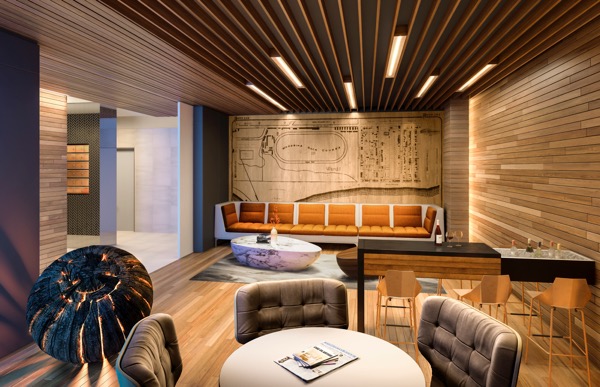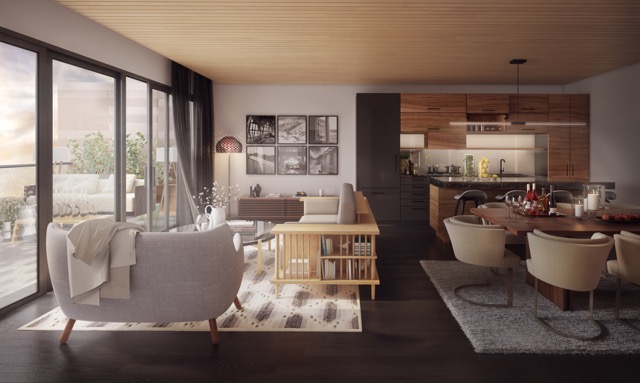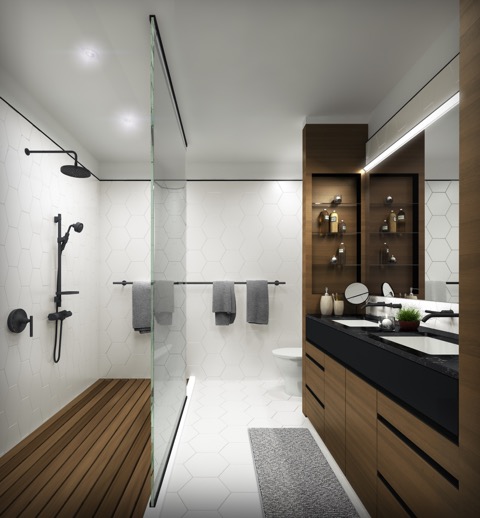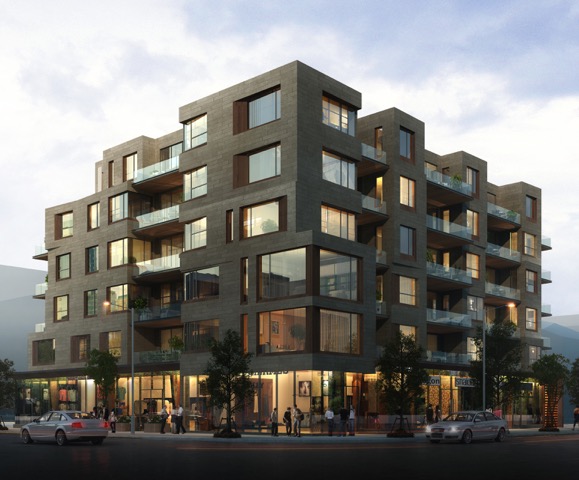
Toronto is known as a city with a vibrant, cross-cultural population mix, but that penchant for diversity is now extending into the housing market as well.
With the construction of Heartwood the Beach Condos, the traditional all-concrete building model will be eschewed in lieu of the city’s first six-storey wood-frame development.
The collection of 40 luxury suites being built at the northeast corner of Woodbine Avenue and Queen Street is being undertaken by Fieldgate Urban, with Hullmark Developments. And Quadrangle Architects were brought on board to design the residential building.
Quadrangle, known for their industry leadership in mid-rise development, also advocate wood construction and were recently awarded the 2015 Wood Advocate Award by WoodWORKS! Ontario.
“It’s always interesting to be working on a new typology,” says Richard Witt, Principal at Quadrangle. “When almost all multi-unit residential buildings in Toronto are concrete, envisioning one in such a naturally beautiful material as wood is very exciting. The sustainability benefits of the product combined with the exposed character and warmth of ceilings and walls within the unit are a completely new option for home buyers.”

The units range from 900 square feet to 1,600 square feet and will include spacious balconies, with a 6,000-foot retail space at ground level.
Quadrangle designed the architecture and the interior design of the building to showcase the elegance of wood-frame construction. Expansive glazing should draw attention to the rich wood interiors that will feature exposed wood ceilings and exposed wood walls.
Wood-frame construction allows the delivery of a higher-quality, equally safe product in a faster time frame with a reduced environmental impact. A substantial portion of the wood components in Heartwood the Beach – floor and wall slabs as well as the exterior – will be prefabricated and assembled onsite. Prefabrication ensures higher quality construction while cutting costs by reduced construction time and onsite accidents.
The skeleton of Heartwood The Beach will be constructed using cross laminated timber (CLT), a strong and lightweight material that exhibits superior thermal, acoustic, and seismic performance, as well as greatly improved fire resistance over basic timber. Unlike concrete and steel, the use of CLT generates very little waste on a construction site, another element in the product’s sustainability. The development will boast a green roof, further offsetting the development’s already minimal carbon footprint.

The project is located at a busy intersection, which makes for a shorter construction timeframe (aided by the prefab wood components) attractive. Not only is the use of wood expected to shorten construction by about four to six months, but it is expected to minimize the amount of disruptive construction that occurs on site. Construction is expected to be finished by early 2017.
Half of the construction time, says Witt, will be allotted to digging and pouring concrete foundations and the underground parking. Finishing will take less time. The speed will come from the use of cross-laminated timber, a strong and lightweight material that exhibits superior thermal, acoustic, and seismic performance, as well as greatly improved fire resistance over basic timber. Unlike concrete and steel, the use of CLT generates very little waste on a construction site, another element in the product’s sustainability. The development will boast a green roof, further offsetting the development’s already minimal carbon footprint.
Although the Ontario Building Code permits structures to be made from wood, it also requires the cladding to be non-combustible. Quadrangle used fibre cement panels. As such, Heartwood the Beach is a hybrid structure, with steel and concrete playing an important role, along with wood, to complete the design.
It is believed that using an engineered lumber product can withstand flame spread and its shrinkage is easier to predict and therefore to accommodate.
With the Heartwood the Beach project, Quadrangle hopes to show that there is an alternative material choice that is both warm and workable for creating sustainable mid-rise developments in the city.
<
“Because of land availability and purchaser trends, there is a tendency at the moment towards an increasing amount of mid-rise building product in the Toronto condo market,” Witt says. “Wood offers the opportunity to deliver the project in a different way due to the factory assembled method of panelized wood production. As noted, this means faster installation, fewer street closures, cleaner and less noisy construction sites and ultimately less time.”
Web / quadrangle.ca / heartwoodthebeach.com